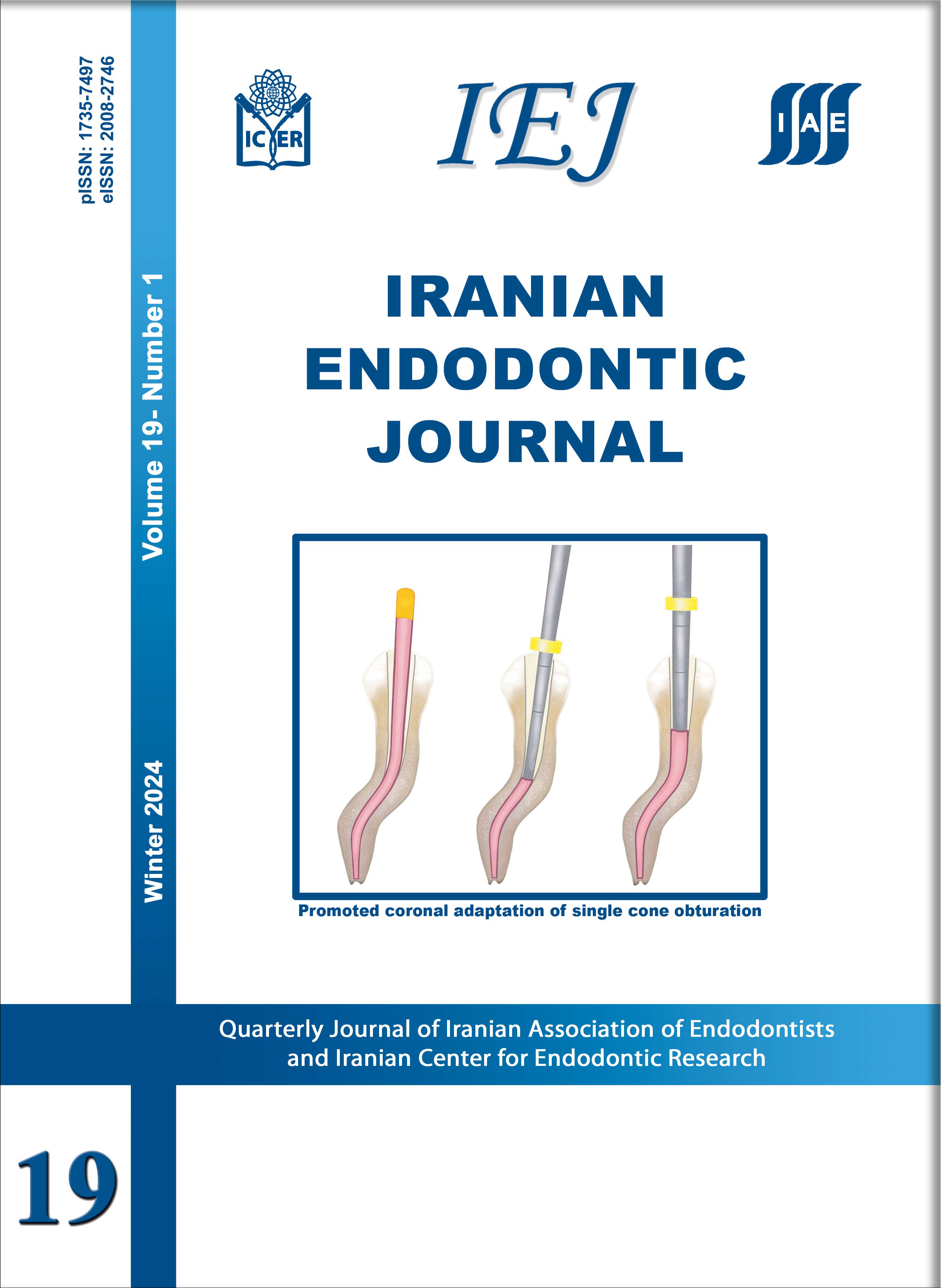The The Accuracy of Three Apex Locators in Determining the Location of Strip Root Perforation in Different Environments
Iranian Endodontic Journal,
Vol. 16 No. 3 (2021),
1 July 2021
,
Page 184-188
https://doi.org/10.22037/iej.v16i3.32515
Abstract
Introduction: The purpose of this study was to assess the accuracy of Root ZX (J. Morita USA, Inc., Irvine, CA, USA), Raypex 6 (VDW, Munich, Germany) and i-Root (S-Denti Co. Ltd Seoul, Korea) electronic apex locators (EALs) in detecting strip root perforations in dry condition, and in presence of 0.9% saline (NaCl), 2.5% sodium hypochlorite (NaOCl), 2% chlorhexidine (CHX), 17% ethylenediaminetetraacetic acid (EDTA) and blood. Methods and Materials: This ex vivo study evaluated 30 extracted human mandibular first molars. After mesiobuccal canal preparation, strip perforation was artificially created in the coronal third of the canal. The actual length (AL) of the canal to the perforation site was measured using a # 70 K-file under a stereomicroscope under 20× magnification. The teeth were then mounted in an alginate mold. The electronic length (EL) of the canal to the perforation site was measured by each apex locator in different environments. The difference between the EL and AL was calculated for each tooth. Statistical analyses were performed using the Friedman and post hoc Dunn tests at P<0.05 level of significance. Results: Most accurate measurements were seen in CHX environment for all three EALs. Root ZX mini in CHX environment showed most accurate reading but no significant difference was observed in three EALs in CHX environment. There was no significant difference between different environment in Root ZX mini (P>0.05). The most difference between the EL and AL were observed in NaOCl environment in Raypex and iRoot (P>0.05). Conclusion: Based on this ex-vivo study, the most accurate measurements were seen for all three EALs in CHX medium. The presence of irrigation solution affected the accuracy of all EALs. Root ZX showed better results compared to other EALs in determining the location of perforation in different environments, but this difference was not significant.
- Electronic Apex Locator; Root Canal Irrigants; Strip Root Perforations
How to Cite
References
2. de Chevigny C, Dao TT, Basrani BR, Marquis V, Farzaneh M, Abitbol S, et al. Treatment outcome in endodontics: the Toronto study—phase 4: initial treatment. J Endod. 2008;34(3):258-63.
3. Tsesis I, Rosenberg E, Faivishevsky V, Kfir A, Katz M, Rosen E. Prevalence and associated periodontal status of teeth with root perforation: a retrospective study of 2,002 patients' medical records. J Endod. 2010;36(5):797-800.
4. Fuss Z, Trope M. Root perforations: classification and treatment choices based on prognostic factors. Dent Traumatol. 1996;12(6):255-64.
5. Fouad AF, Reid LC. Effect of using electronic apex locators on selected endodontic treatment parameters. J Endod. 2000;26(6):364-7.
6. Vieyra J, Acosta J, Mondaca J. Comparison of working length determination with radiographs and two electronic apex locators. Int Endod J. 2010;43(1):16-20.
7. Altunbaş D, Kuştarcı A, Toyoğlu M. The influence of various irrigants on the accuracy of 2 electronic apex locators in locating simulated root perforations. J Endod. 2017;43(3):439-42.
8. Marigo L, Gervasi GL, Somma F, Squeo G, Castagnola R. Comparison of two electronic apex locators on human cadavers. Clin Oral investig. 2016;20(7):1547-50.
9. Jung I-Y, Yoon B-H, Lee S-J, Lee SJ. Comparison of the reliability of “0.5” and “APEX” mark measurements in two frequency-based electronic apex locators. J Endod. 2011;37(1):49-52.
10. Pilot TF, Pitts DL. Determination of impedance changes at varying frequencies in relation to root canal file position and irrigant. J Endod. 1997;23(12):719-24.
11. Shin H-S, Yang W-K, Kim M-R, Ko H-J, Cho K-M, Park S-H, et al. Accuracy of Root ZX in teeth with simulated root perforation in the presence of gel or liquid type endodontic irrigant. Restor Dent Endod. 2012;37(3):149-54.
12. Allam CR. Treatment of stripping perforations J Endod. 1996;22(12):699-702.
13. D'assunção FLC, Sousa JCN, Felinto KCA, De Medeiros TC, Leite DT, De Lucena RB, et al. Accuracy and repeatability of 3 apex locators in locating root canal perforations: an ex vivo study. J Endod. 2014;40(8):1241-4.
14. Moghaddam KN, Nazari S, Shakeri L, Honardar K, Mirmotalebi F. In vitro detection of simulated apical root perforation with two electronic apex locators. Iran Endod J. 2010;5(1):23.
15. Zmener O, Grimberg F, Banegas G, Chiacchio L. Detection and measurement of endodontic root perforations using a newly designed apex‐locating handpiece. Dent Traumatol. 1999;15(4):182-5.
16. Fuss Z, Assooline LS, Kaufman AY. Determination of location of root perforations by electronic apex locators. Oral Surg, Oral Med, Oral Pathol, Oral Radiol, Endod. 1996;82(3):324-9.
17. Khursheed I, Bansal R, Bansal T, Singh HP, Yadav M, Reddy KJ. A comparative evaluation of working length with digital radiography and third generation apex locator (ProPex) in the presence of various intracanal irrigants: An in vivo/ex vivo study. Dent Res J. 2014;11(1):56.
18. Jenkins JA, Walker III WA, Schindler WG, Flores CM. An in vitro evaluation of the accuracy of the root ZX in the presence of various irrigants. J Endod. 2001;27(3):209-11.
19. Marek E, Łagocka R, Kot K, Woźniak K, Lipski M. The influence of two forms of chlorhexidine on the accuracy of contemporary electronic apex locators. BMC Oral Health. 2020;20(1):3.
20. Khatri MP, Ghivari SB, Pujar M, Faras R, Gopeshetti P, Vanti A. Accuracy of two electronic apex locators in locating root perforations in curved canals in dry and wet conditions: A comparative in vitro study. Dent Res J. 2019;16(6):407-412.
21. Bilaiya S, Patni PM, Jain P, Pandey SH, Raghuwanshi S, Bagulkar B. Comparative Evaluation of Accuracy of Ipex, Root Zx Mini, and Epex Pro Apex Locators in Teeth with Artificially Created Root Perforations in Presence of Various Intracanal Irrigants. Eur Endod J. 2020;5(1):6-9.
- Abstract Viewed: 516 times
- PDF Downloaded: 273 times




